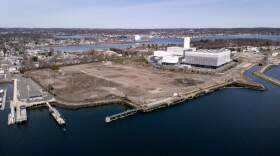Researchers at the University of New Hampshire are partnering with the first utility-scale offshore wind project approved in the U.S., Vineyard Wind, to gather data on underwater sounds and how they could affect marine life.
Listen to Windfall: NHPR’s podcast about the burgeoning offshore wind industry in the U.S.
Jennifer Miksis-Olds is the director of UNH’s Center for Acoustic Research and Education. She said balancing the need for clean energy with maintaining a healthy ocean environment is important. But it’s complicated.
More development of offshore wind can bring more noise to marine environments, which could have a big impact on marine mammals, which use sound to communicate underwater.
“If you’ve ever opened your eyes underwater, you can’t see very far. Light underwater doesn’t travel very far. Whereas sound travels fast and far underwater,” she said. “Marine mammals, for example, use sound to keep in touch.”
Those mammals need to listen for predators and prey, and use sound to find mates.
Miksis-Olds said the university’s work with Vineyard Wind will last throughout the time during which the company is required by federal regulations to monitor their activity, throughout five years of construction, operation and maintenance of 62 offshore wind turbines off the coast of Massachusetts.
The project is expected to generate enough electricity annually to power 400,000 homes, according to Vineyard Wind. The company said that’s equivalent to removing 325,000 vehicles from the road.
Researchers at UNH will use groups of underwater microphones to record the sounds of the ocean – waves, fish, boats, mammals and construction activities like pile driving – continuously throughout the project.
They’ll be listening for how underwater sounds are changing throughout the stages of the project from a pre-construction baseline, and whether marine animals are changing their patterns in ways that are associated with human activities.
That information could help offshore wind companies plan construction and maintenance in ways that would have less of an impact on marine animals.
“Knowing when they’re there also allows industry, for example, to focus their work at times when animals may not be there at a seasonal peak,” Miksis-Olds said.
Understanding marine mammal migration is especially important as climate change shifts the underwater environment.
“There have been some changes that we’ve seen in migration where animals sometimes will stay up in the Gulf of Maine for an entire year,” Miksis-Olds said. “It’s really critical to be able to monitor the Gulf of Maine, for example, for large protected whales year round now.”
UNH will fund a full PhD student throughout the five-year project in their College of Engineering and Physical Sciences to do this work, and use data collected throughout the project to teach undergraduates about marine ecology and acoustics.






